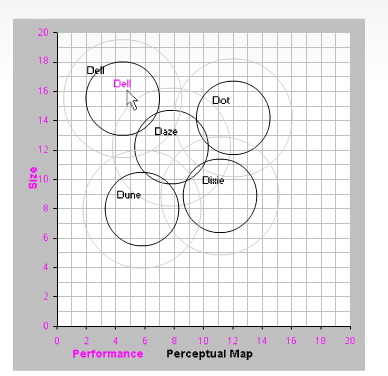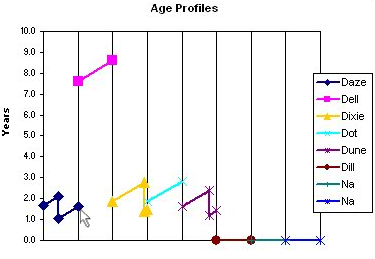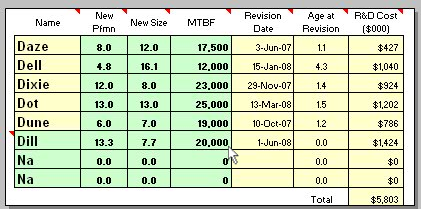Research & Development must ensure products meet changing customer demands by revising the line to keep up with segment drift.
R&D decisions control four product attributes:
- SIZE The sensor's weight and girth.
- PERFORMANCE The sensor's speed and throughput in measuring and reporting conditions.
- RELIABILITY How long the sensor lasts before it fails.
- AGE The number of years the product has been in the market.

To reposition an existing product on the R&D screen, enter new coordinates for performance and/or size. To keep up with the segment drift, products must be made smaller and their performance higher.

As revision projects begin, the product appears twice on the perceptual map, once in black, indicating its present position, and once in magenta, indicating where it will be when the revision concludes.
Among other factors, the time the revision takes depends upon the distance the product is moved on the map; the farther the move, the longer the project.
As more projects are added, the extra burden puts a strain on R&D which increases the time needed to complete each project.

Customers in each segment expect different levels of reliability. Reliability is expressed as Mean Time Between Failure, or MTBF. MTBF predicts the number of hours a product will work before it fails.
MTBF is changed on the R&D screen. Products can be manufactured with MTBFs above or below the range that customers expect. Customers are indifferent to products with MTBFs above the range, but for every 1,000 hours below the range, demand drops by 20%. At 5,000 hours below the range demand drops to 0.
As products become smaller, faster and more reliable, their material costs increase making them more expensive to produce so it's a challenge for R&D to design products that conform to customer demand, while controlling material cost.

The last product attribute controlled by the R&D Department is the Age. High-Tech customers prefer newer products, Low Tech, older proven products.

Newly invented products have an age of 0. They start to age the day they emerge from R&D.When R&D invents a new product, it is given a Name, Size, Performance and MTBF. The size, performance and MTBF should be appropriate for the intended segment.

However, technology marches on, and eventually teams might decide to reposition a product on the perceptual map. When the revision project completes, the product's age will be cut in half. The "new, improved" revised product is not as dated as the original, but it is not brand new either. Customers perceive the age to be half of what it was just prior to the revision.
Just changing MTBF, however -without changing the product's size or performance -does not affect its perceived age.
